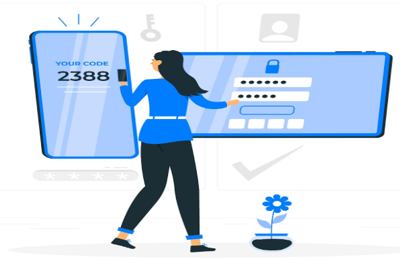|
Page 1 of 2 Improve the overall security of your apps and reduce the risk of data breaches and cyber attacks by implementing two-factor authentication. Here's what you need to know.

As users we are used to getting a code as a What's App message or an SMS and copying it to an app we want to run. But as developers are we actually implementing this idea?
What Is Two-Factor Authentication (2FA)?
Two-Factor Authentication (2FA), also known as two-step verification or dual-factor authentication, is a security process that requires a user to provide two different types of authentication factors to verify their identity when accessing an account, system, or online service. Understanding the significance of identity and access management is essential when you aim to incorporate two-factor authentication into your applications.
By requiring two independent factors for authentication, 2FA makes it significantly more difficult for an attacker to gain unauthorized access, as they would need to compromise both factors rather than just one (like a stolen password). Many online services, such as email providers, social media platforms, and banking websites, now offer 2FA as an option to enhance security for their users and improve user management .
Types of Authentication Techniques
There are several types of authentication processes, each with its own set of features and use cases:
-
Single Sign-On (SSO): SSO authentication is a process that allows users to access multiple, related applications or services using a single set of credentials, such as a username and password. SSO simplifies the user experience by reducing the need to remember multiple usernames and passwords for different applications or systems.
-
Adaptive Authentication: Adaptive authentication uses context-aware and risk-based authentication methods to determine the appropriate level of authentication required for a given situation. This may involve analyzing factors like the user's location, device, behavior, or risk profile, and adjusting the authentication process accordingly
-
Federated Authentication: Federated authentication is a process that enables users to authenticate with multiple, unrelated systems or services using a single set of credentials. This is achieved through trust relationships between participating organizations and often relies on protocols like SAML, OpenID Connect, or OAuth to securely exchange user information.
-
Continuous Authentication: Continuous authentication is an ongoing process that monitors and evaluates user behavior and other factors throughout a session, rather than just at the initial login. This approach can help detect and respond to potential security threats in real-time, such as unauthorized access or session hijacking.
How Does Two-Factor Authentication Work?
Here's a general overview of how the 2FA process works:
-
The user enters their username and password (or another knowledge-based factor) on the login page of the service or application. This is the first authentication factor.
-
If the first factor is correct, the system prompts the user to provide the second authentication factor. This could be a one-time code generated by a mobile app, a code sent via SMS or email, a physical token, or a biometric factor like a fingerprint.
-
The user submits the second factor as prompted. The system verifies the second factor to ensure it is valid and associated with the user's account.
-
If both factors are successfully verified, the user is granted access to the secure account or service. If either factor fails verification, access is denied.
Common Types and Examples of Two-Factor Authentication
Here are some common types and examples of two-factor authentication:
- Hardware Tokens for Two-Factor Authentication: Hardware tokens are physical devices that generate one-time passcodes that are used as the second factor for authentication. These tokens can be carried on a keychain or kept in a wallet. They work by generating a unique code that changes every 30 seconds or so, which is used to authenticate the user.
- SMS Text-Message and Voice-Based 2FA:
This method of 2FA involves sending a one-time code via SMS or phone call to the user's registered phone number. The user enters this code as the second factor during login. SMS and voice-based 2FA can be convenient, but they have some vulnerabilities, such as attacks attempting to intercept the text or call.
- Software Tokens for 2FA:
This method of 2FA involves sending a one-time code via SMS or phone call to the user's registered phone number. The user enters this code as the second factor during login. SMS and voice-based 2FA can be convenient, but they have some vulnerabilities, such as SIM swapping attacks.
- Push Notification for 2FA:
This method sends a push notification to the user's registered mobile device when they attempt to log in. The user is prompted to approve or deny the login attempt. If approved, access is granted. Push notifications can be more secure than SMS-based 2FA as they are less susceptible to interception or cloning.
Adding 2FA to Your App
There are various libraries available for different programming languages to help you implement 2FA in your app. Here are some popular libraries for adding 2FA using Time-Based One-Time Password (TOTP), which is one of the most common methods:
-
Google Authenticator Java Library: A Java server-side library compatible with Google Authenticator, used for generating and verifying TOTP.
-
PyOTP: A Python library for generating and verifying OTPs, supporting both HOTP and TOTP.
-
JOTP: A Java library that supports TOTP and HOTP generation and verification.
-
otp: A Go library for generating and validating TOTP and HOTP.
|
